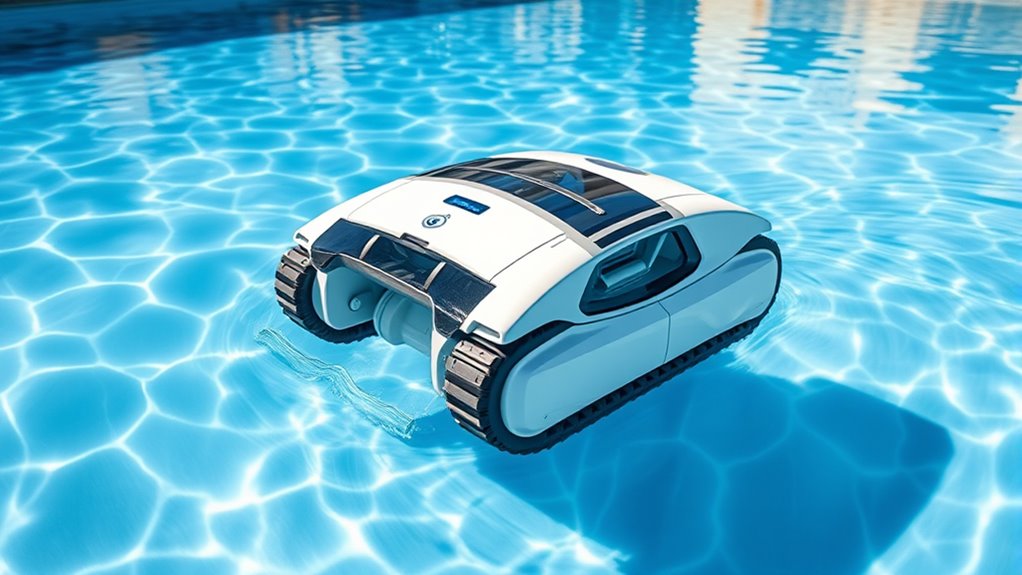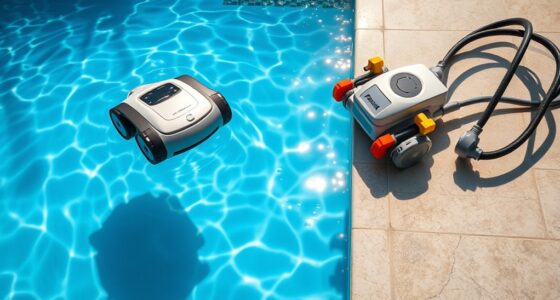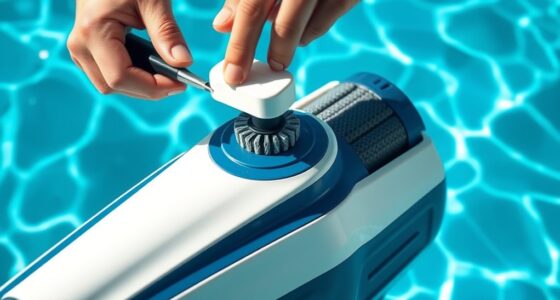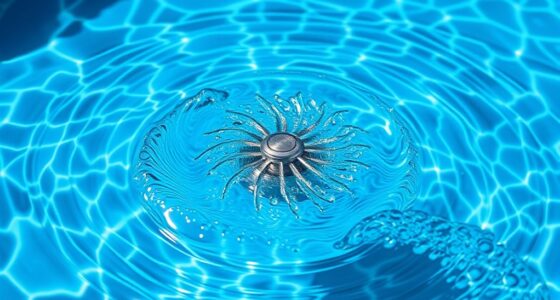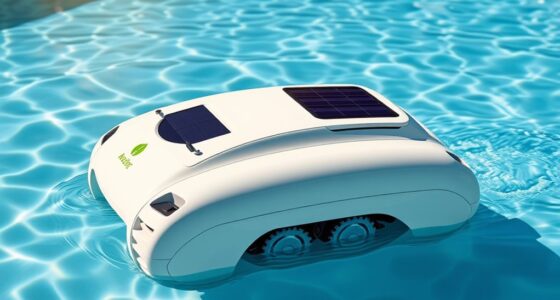The automatic pool cleaners industry is growing fast, driven by your desire for convenience, eco-friendly features, and advanced technology like AI and smart navigation. You’ll find different types, from robotic models to suction and pressure cleaners, tailored to your pool’s needs. Manufacturers focus on durability, efficiency, and sustainability, but challenge areas include battery life and complex pool layouts. To explore how innovations are shaping this industry and how market trends affect you, keep exploring further.
Key Takeaways
- The industry is driven by consumer demand for efficient, eco-friendly, and technologically advanced automatic pool cleaning solutions.
- Robotic cleaners dominate market share, featuring AI navigation, smart connectivity, and durable, eco-friendly materials.
- Market growth is fueled by urbanization, lifestyle changes, and a focus on sustainability and energy-efficient features.
- Challenges include battery limitations, navigation inefficiencies, and regulatory standards for safety and environmental compliance.
- Future trends emphasize AI integration, biodegradable components, solar-powered options, and smart, low-maintenance pool cleaning devices.
Market Growth and Industry Drivers
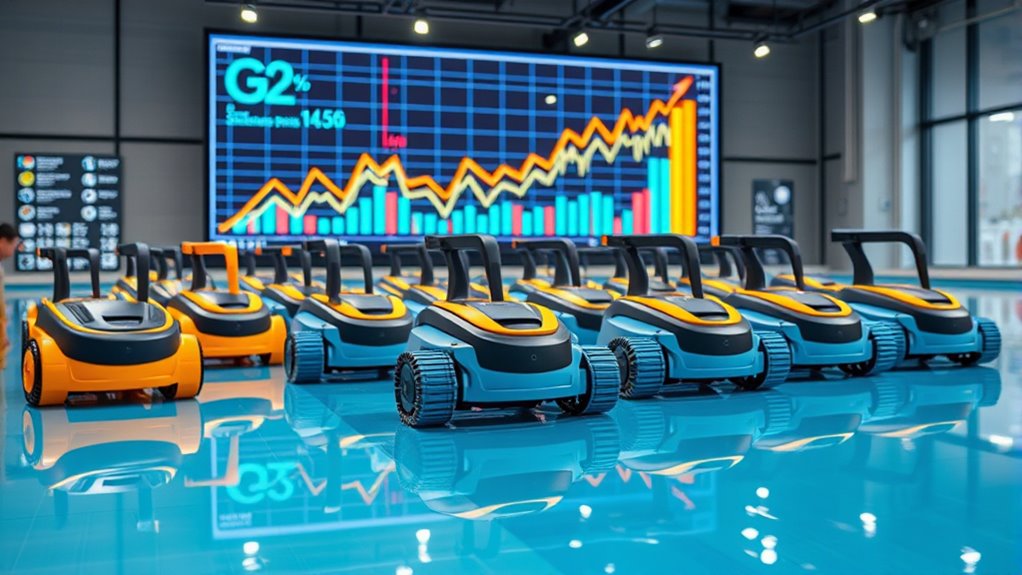
The automatic pool cleaners industry has experienced steady growth in recent years, driven primarily by increasing demand for convenience and time-saving solutions among pool owners. Consumers now prefer eco-friendly materials that reduce environmental impact, which has pushed manufacturers to innovate with sustainable components. Additionally, smart connectivity features have become a significant industry driver, allowing you to control and monitor your cleaner remotely via apps or smart devices. These advancements improve efficiency, ease of use, and integration with smart home systems, making cleaning more automated and less labor-intensive. As a result, the industry’s expansion reflects a shift toward environmentally conscious, technologically advanced products that cater to modern lifestyles and heightened expectations for simplicity and sustainability.
Types of Automatic Pool Cleaners
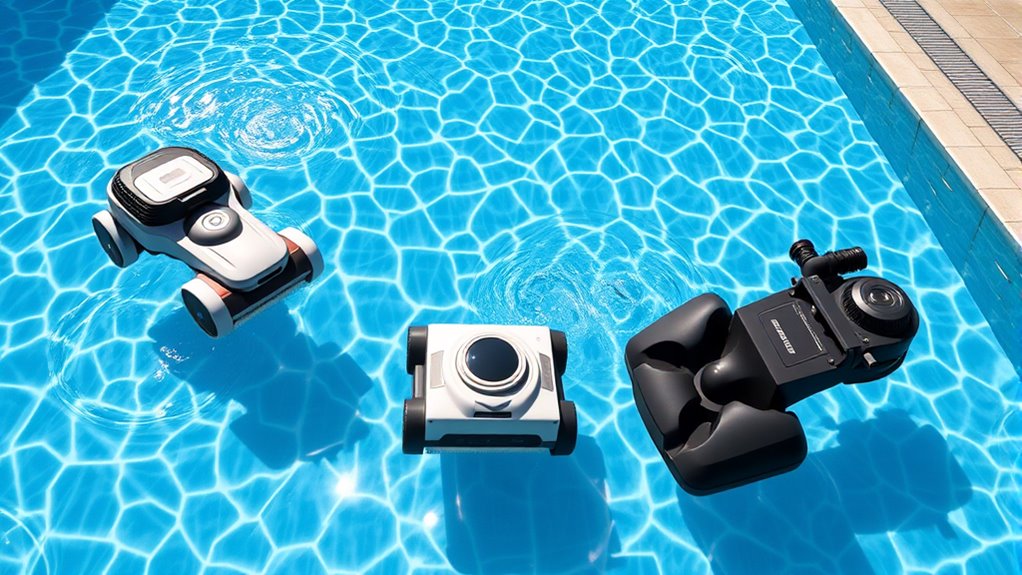
There are several types of automatic pool cleaners designed to fit different needs. You can choose between robotic cleaners, which operate independently, and suction or pressure models that connect to your pool’s system. Additionally, manual options require more effort, while automatic cleaners handle the cleaning process for you. Embracing Life’s Awkward Moments can also teach patience and resilience, much like troubleshooting pool cleaner issues.
Robotic Cleaner Designs
Robotic pool cleaners come in various designs tailored to different cleaning needs and pool types. These designs include wall-climbing units, flat-surface cleaners, and models with specialized brushes for algae removal. When choosing a robotic cleaner, consider battery efficiency, which determines how long the device can operate without recharging, and material durability, essential for withstanding harsh pool chemicals and constant water exposure. Some models feature slim profiles for tight corners, while others have larger debris bins for extended cleaning sessions. The shape and mobility of each design influence cleaning performance and ease of use. Overall, the variety in robotic cleaner designs allows you to select a model that best fits your pool’s size, shape, and specific cleaning requirements. Additionally, understanding the effectiveness of different designs can help you choose a model that provides optimal cleaning results. For optimal performance, consider how color accuracy and contrast ratio impact the visibility of debris and cleanliness indicators. Recognizing these factors can help you assess which model offers better navigation and more comprehensive cleaning coverage. Moreover, advancements in sensor technology can further enhance a robotic cleaner’s ability to adapt to complex pool layouts and obstacles.
Suction vs. Pressure Models
Suction and pressure pool cleaners represent two primary types of automatic cleaning systems, each with distinct operation methods and advantages. Suction cleaners use your pool’s skimmer or dedicated port to create suction, allowing them to efficiently pick up debris from the floor and walls. They typically offer high cleaning efficiency on dirt and small debris, but might struggle with larger objects. Advancements in AI technology are also being integrated into some modern pool cleaning systems to optimize navigation and debris detection. Additionally, the choice between them can depend on the type of debris most common in your pool, as each model performs better with certain debris sizes and types. The design and layout of your pool can influence which type of cleaner works best, as some models are better suited for irregular shapes or specific surface features. Pool surface characteristics also affect the effectiveness of each type, with some cleaners performing better on textured or smooth surfaces. The size of debris in your pool can further determine which cleaner is more suitable, as larger debris may require more powerful equipment. Pressure cleaners operate using water pressure from a booster pump, propelling the cleaner around the pool and pushing debris into a bag. They generally have higher noise levels but excel at removing larger debris and covering larger surface areas quickly. Your choice depends on your cleaning needs; suction models tend to be quieter with better dirt pickup, while pressure models offer robust cleaning for bigger debris.
Manual vs. Automatic Options
When choosing a pool cleaning method, you can opt for manual or automatic options, each offering different levels of convenience and control. Manual operation requires you to physically clean the pool using a brush or net, giving you direct control but demanding more effort and time. Automatic pool cleaners, on the other hand, handle the job with minimal input, providing greater user convenience. These devices come in various types, like robotic cleaners, pressure-side, and suction-side models, each designed to simplify maintenance. While manual cleaning offers flexibility, automatic options save you time and effort, making pool maintenance less of a chore. Your choice depends on how much control you want versus how much convenience you need for your pool upkeep. Understanding different types of automatic pool cleaners can help you make an informed decision tailored to your needs. Additionally, automatic pool cleaning technology continues to advance, offering more efficient and user-friendly options, with some models now featuring smart navigation systems that optimize cleaning paths and reduce energy use. Modern automatic pool cleaners often incorporate ECU tuning principles to improve their operational efficiency and adaptability, and staying informed about industry innovations can help you select the best device for your pool.
Key Technologies and Innovations
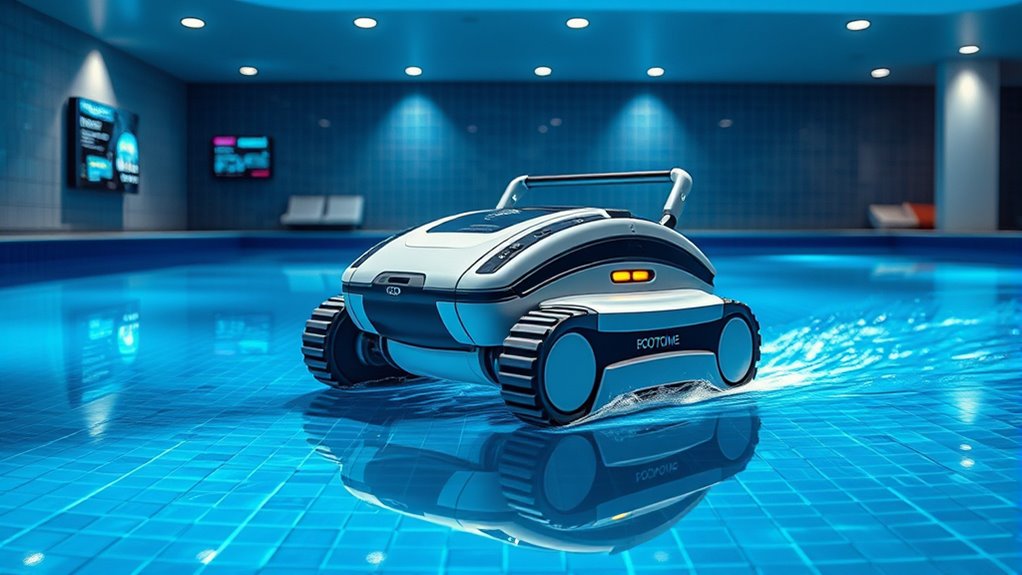
Advancements in technology have substantially transformed automatic pool cleaners, making them smarter, more efficient, and easier to operate. One key innovation is smart sensor integration, which allows cleaners to detect obstacles, dirt levels, and water conditions in real-time. This guarantees more thorough cleaning and prevents unnecessary overlaps. Employing cost-effective strategies can further enhance the efficiency of these systems by reducing operational costs and improving user experience. AI-driven navigation is another breakthrough, enabling cleaners to map your pool and plan ideal cleaning routes, reducing time and energy consumption. These technologies work together to create a seamless cleaning experience, adapting to different pool shapes and sizes. With smart sensors and AI navigation, your pool cleaner becomes highly autonomous, requiring minimal supervision and delivering consistently better results. Additionally, ongoing research and development are focused on integrating user-friendly features that make operation more intuitive for all users. Studies indicate that the integration of these advanced features significantly enhances cleaning efficiency and overall performance in the automatic pool cleaners industry. Furthermore, incorporating AI security measures helps safeguard the device’s operation against potential vulnerabilities, ensuring reliable and safe performance.
A recent focus on cost-benefit analysis in the industry emphasizes optimizing these innovations to maximize value for consumers.
Major Manufacturers and Market Share

Leading manufacturers in the automatic pool cleaner industry have harnessed the latest technological innovations to gain a competitive edge. Major players like Zodiac, Dolphin, and Hayward dominate the market through manufacturer dominance, leveraging advanced features and brand reputation. Market segmentation reveals that robotic cleaners hold a significant share, appealing to consumers seeking efficiency and automation, while suction and pressure cleaners serve more budget-conscious buyers. These companies focus on innovation, quality, and global distribution channels to maintain their positions. As a result, market share remains concentrated among a few key manufacturers, although emerging brands are gradually gaining ground by offering competitive pricing and unique features. Understanding this landscape helps you recognize the industry’s competitive dynamics and the importance of manufacturer influence in shaping market trends. Additionally, personality traits such as innovation and adaptability play a crucial role in how companies develop and market their products in this evolving industry. A focus on technological advancements has continuously driven product improvements and consumer satisfaction in this competitive environment, especially as companies invest in product innovation to stay ahead. Furthermore, embracing renewable energy solutions can enhance the sustainability and efficiency of pool cleaning technologies, aligning with broader green living trends. The integration of environmentally sustainable practices also influences consumer preferences and industry standards.
Consumer Preferences and Purchasing Trends
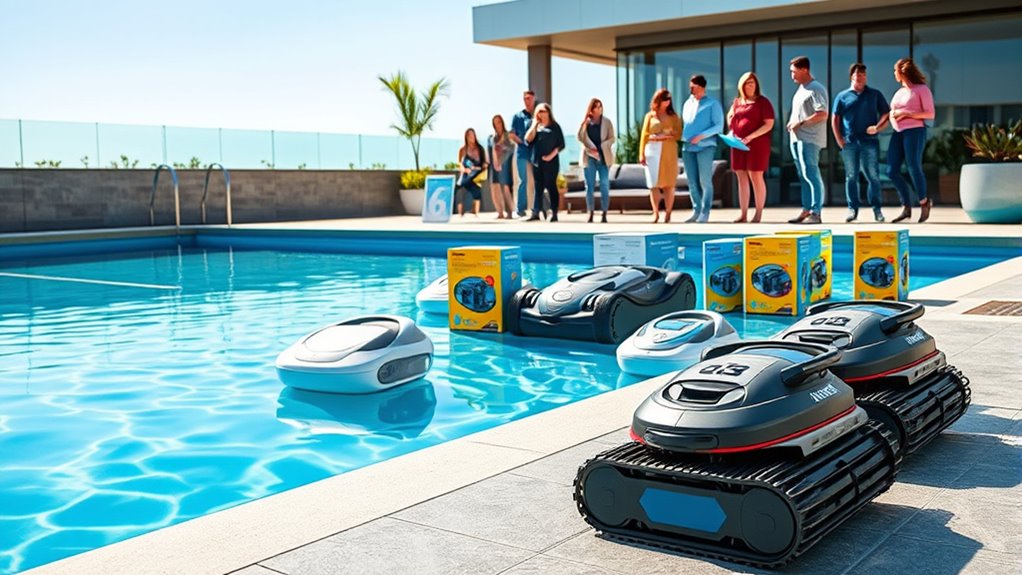
You’re likely noticing that consumers prioritize advanced technological features when choosing automatic pool cleaners, such as smart navigation and app control. Price sensitivity also plays a big role, with many shoppers balancing cost against the latest innovations. Understanding these trends can help you better anticipate what buyers want and tailor your offerings accordingly. Additionally, some consumers are drawn to classic arcade themes which influence their preference for certain brands or models that evoke nostalgia and familiarity.
Technological Feature Preferences
When choosing an automatic pool cleaner, you prioritize technological features that enhance efficiency, ease of use, and durability. Smart navigation is a top preference, allowing the cleaner to map your pool and cover the entire surface without missing spots. This reduces cleaning time and improves overall performance. Energy efficiency also matters, as you want a model that consumes less power while maintaining strong cleaning capabilities. Consumers look for advanced sensors and algorithms that optimize movement and maximize battery life. Durability is essential, too, so you choose cleaners with sturdy components that withstand regular use and exposure to water. These technological features ensure your pool stays clean with minimal effort, making them key factors in your purchasing decision.
Price Sensitivity Trends
As consumers become more aware of technological features that boost cleaning efficiency and durability, their willingness to pay varies based on price sensitivity trends. Pricing elasticity plays a key role—some buyers are willing to pay a premium for advanced features, while others are highly cost-sensitive and seek budget options. You’ll notice that as prices rise, demand may decrease among cost-sensitive consumers, reflecting high price sensitivity. Conversely, those less sensitive to price might prioritize reliability and innovation, showing lower price elasticity. This trend influences manufacturers to balance feature enhancements with competitive pricing. Understanding these dynamics helps you, as a consumer, make informed decisions, whether you prioritize value or cutting-edge technology. Ultimately, the industry’s pricing strategies align with these evolving consumer preferences and purchasing trends.
Challenges and Limitations
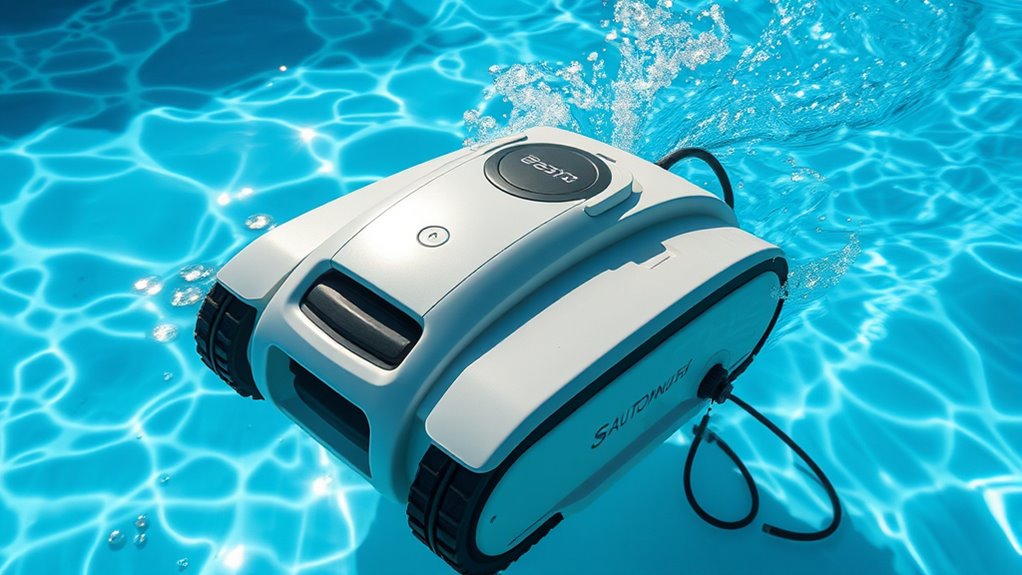
Despite their convenience, automatic pool cleaners face several challenges that hinder widespread adoption and ideal performance. One major issue is battery limitations, which restrict cleaning time and require frequent recharging, reducing efficiency. Additionally, navigation challenges pose significant hurdles; many units struggle to accurately map and clean complex pool shapes, leading to missed spots and repeated coverage. These issues can frustrate users and diminish the perceived value of the devices. furthermore, battery degradation over time further reduces performance and increases maintenance costs. While technological advancements are ongoing, overcoming these limitations remains essential for broader acceptance. Without improvements in battery capacity and smarter navigation systems, automatic pool cleaners will continue to face obstacles that limit their effectiveness and appeal to consumers.
Regulatory Environment and Standards
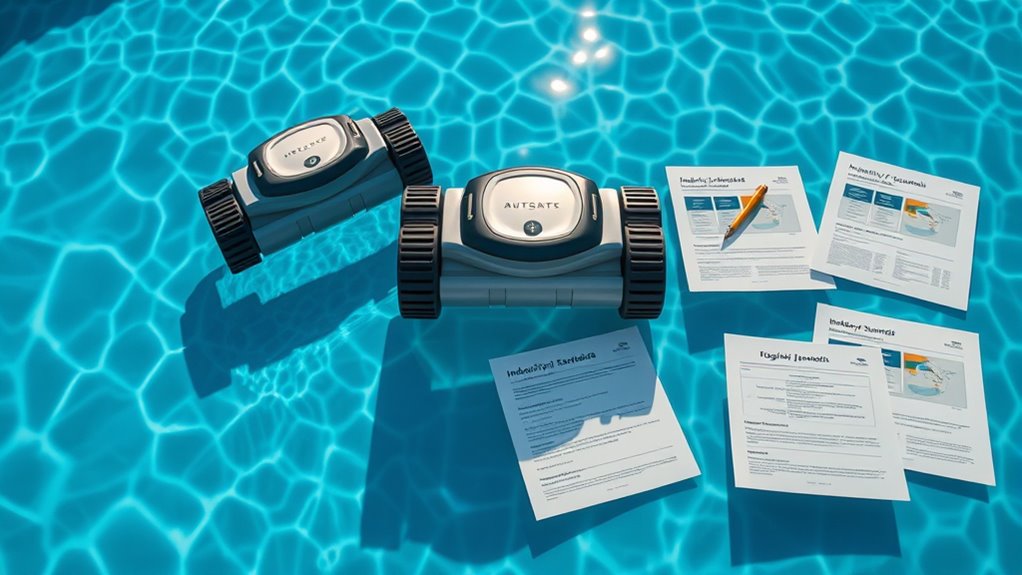
The regulatory environment and standards play a crucial role in shaping the automatic pool cleaners industry by setting safety, performance, and environmental requirements. You must guarantee regulatory compliance to meet local, national, and international standards, which safeguard users and promote product reliability. Industry standards, such as those established by organizations like UL or IEC, provide benchmarks for safety features, electrical components, and energy efficiency. Staying updated with evolving regulations helps you avoid legal issues and market restrictions. Manufacturers are responsible for designing products that pass certification processes, demonstrating adherence to these standards. This regulatory framework fosters consumer trust and encourages innovation, ensuring that automatic pool cleaners remain safe, effective, and environmentally friendly in a competitive marketplace.
Future Outlook and Emerging Opportunities
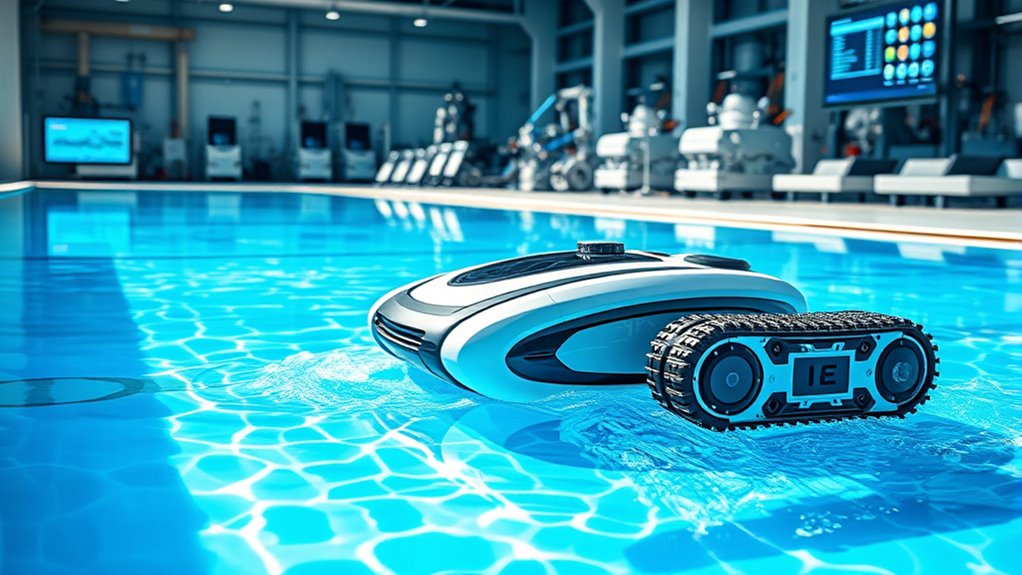
The future of the automatic pool cleaners industry looks promising, driven by advancements in technology and increasing consumer demand for convenience and cleanliness. You can expect innovations like smart integration, enabling devices to connect seamlessly with home automation systems for better control and scheduling. Additionally, eco-friendly materials will become more prevalent, aligning with sustainability trends and reducing environmental impact. Emerging opportunities include solar-powered models and biodegradable components, appealing to eco-conscious consumers. Companies will focus on enhancing efficiency and user experience through AI and sensor technology. Here’s a snapshot of future trends:
| Technology Focus | Sustainability Focus | Consumer Benefits |
|---|---|---|
| Smart integration | Eco friendly materials | Increased convenience |
| AI-powered navigation | Biodegradable parts | Cost savings over time |
| Sensor-based cleaning | Solar-powered options | Improved cleaning effectiveness |
Impact of Urbanization and Lifestyle Changes
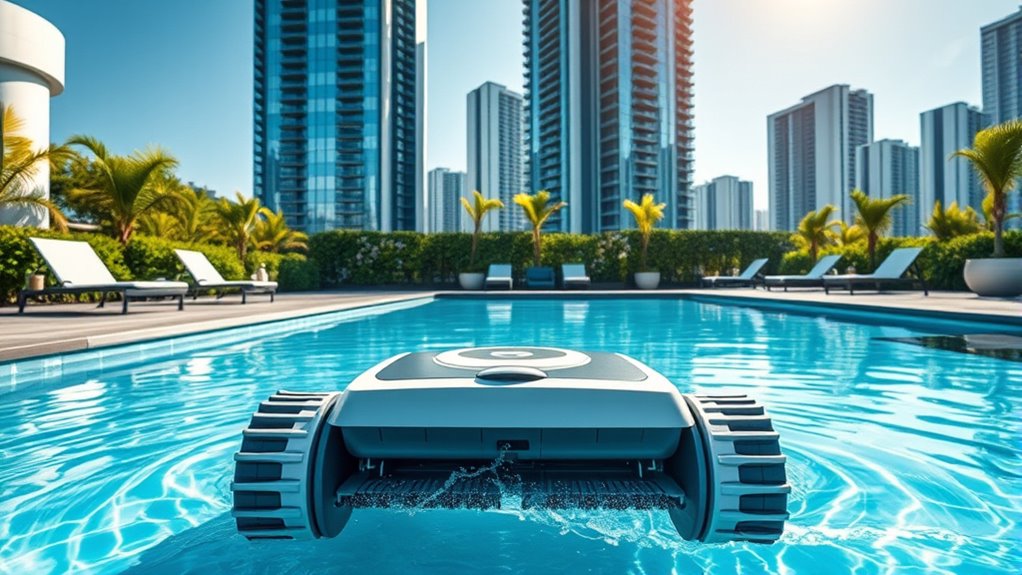
As urbanization accelerates, more households prioritize maintaining clean, safe pools without dedicating excessive time or effort. Urban sprawl expands residential areas, making traditional pool maintenance less practical for busy families. Lifestyle trends favor convenience, leading many to seek automated solutions like automatic pool cleaners. These devices help homeowners keep pools pristine despite limited outdoor space or time constraints. As urban living becomes more fast-paced, the demand for efficient, low-maintenance pool care rises. People want to enjoy their pools without the hassle of manual cleaning or complex upkeep. This shift directly influences industry growth, encouraging manufacturers to develop smarter, more effective pool cleaning technologies that align with evolving urban lifestyles. Overall, urbanization and changing lifestyle trends drive the increasing adoption of automatic pool cleaners.
Frequently Asked Questions
What Are the Environmental Impacts of Automatic Pool Cleaners?
You might wonder about the environmental impacts of automatic pool cleaners. These devices can be eco-friendly if they use sustainable materials and have low energy consumption. By choosing models made from eco-friendly materials, you reduce harmful waste, and energy-efficient cleaners help lessen your carbon footprint. Overall, being mindful of these factors allows you to enjoy a clean pool while minimizing environmental harm.
How Do Seasonal Changes Affect Pool Cleaner Performance?
Seasonal changes can critically impact your pool cleaner’s performance. You need to perform seasonal maintenance to guarantee it works efficiently year-round. Weather adaptation is vital—during colder months, some cleaners may struggle or need adjustments, while in warmer seasons, debris increases, requiring more frequent cleaning. By adjusting your pool cleaner’s settings and maintaining it properly, you’ll keep your pool clean and operational regardless of seasonal shifts.
Are There Any Maintenance Costs Associated With Different Cleaner Types?
You’ll find that maintenance costs vary depending on the cleaner type. For example, robotic cleaners may have a higher initial cost but lower repair frequency, saving you money long-term. In contrast, pressure and suction cleaners typically have lower upfront costs but can require more frequent repairs, increasing overall expenses. A cost comparison helps you decide which cleaner suits your budget, ensuring you balance maintenance costs and durability for your pool needs.
How Does the Integration of Smart Home Technology Influence Market Growth?
Think of smart home integration as a bridge connecting your pool to the digital world. When you add smart features, you’re not just upgrading convenience but fueling market expansion. This tech-savvy approach attracts a broader audience, making automatic pool cleaners more appealing. As a result, the industry grows faster, with more innovations and options, transforming your pool experience into a seamless, intelligent oasis that keeps pace with your connected lifestyle.
What Are Consumers’ Primary Concerns When Choosing an Automatic Pool Cleaner?
When choosing an automatic pool cleaner, you mainly focus on cost considerations and ease of use. You want a device that fits your budget but still offers reliable cleaning. Ease of use matters too—you prefer models that are simple to operate and maintain without hassle. You’re likely concerned about durability and efficiency, ensuring the cleaner performs well over time while being straightforward to handle, making your pool maintenance easier and more cost-effective.
Conclusion
As you navigate this bubbling industry, remember it’s like a river constantly evolving, driven by innovation and changing lifestyles. The current pushes toward smarter, more efficient cleaners, opening new horizons. Embrace these waves of change, for they promise a future where sparkling pools become effortless escapes. Stay tuned, for this industry is a vibrant tapestry, weaving together technology, preferences, and opportunity—inviting you to plunge into the endless possibilities ahead.
